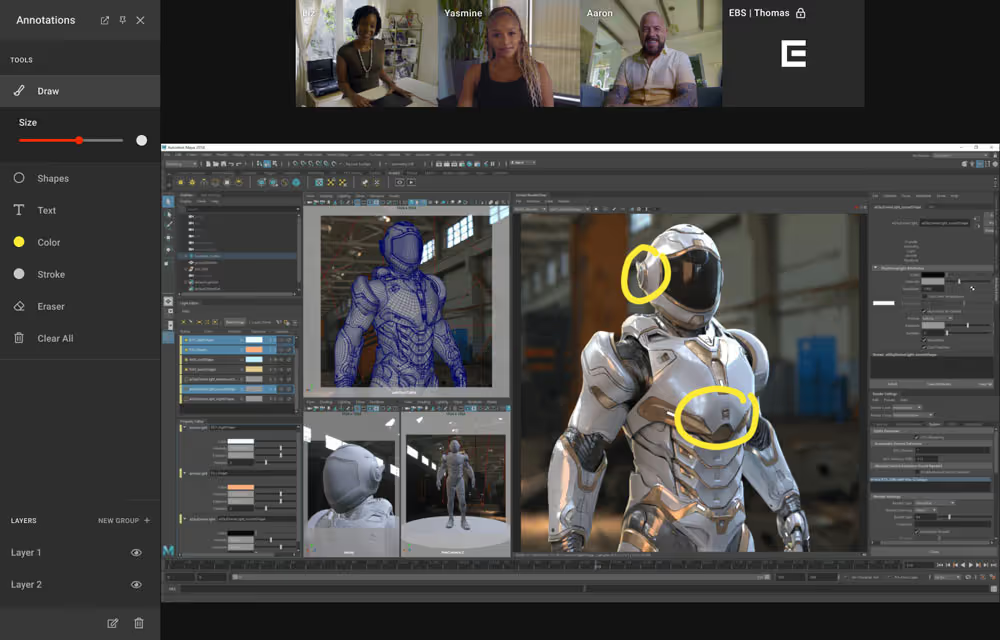Creative professionals – anyone working in media, entertainment, gaming, advertising, music, etc. – have special needs for remote collaboration and communication that simply can’t be addressed with the traditional conference call software.
In a perfect world, creatives working remotely on video content should be able to talk face-to-face while securely reviewing footage from wherever they are located and easily comment and make notes.
Additionally, due to issues such as intellectual property rights and piracy, security is always paramount. Add to the fact that co-workers are often spread out across the globe, you are also often dealing with bandwidth, CPU, and latency issues that can quickly lead to communication breakdowns (and perhaps a few tears).
In the past few years, several tech companies have developed platforms promising to solve these myriad of challenges. But how do they stack up to one another? In this blog post we’ll take a deep dive, comparing functionality, features, and services so you can make an informed decision.
What’s out there?
In a nutshell, some of the top remote collaboration and video conferencing software tools used by creative professionals are:
- Evercast - combines video conferencing, 4K/60fps live streaming, and creative collaboration features on a secure platform.
- Zoom - online meetings, phone, screen sharing and real-time chat on any device including iOS and Android.
- Microsoft Teams - the collaborative component of Microsoft 365 that lets people discuss as well as work on projects/documents together.
- cineSync - real-time sync for footage review, annotation and approval.
- ClearView Flex - high-resolution, low latency collaboration from pre-production to FX with color and audio accuracy.
Other popular video conferencing solutions include GoToMeeting, BlueJeans, Cisco Webex, Discord, and Skype. (For the purposes of this piece, however, we’ll only focus on the ones above.)
On the surface, most of these solutions seem the same: they all use buzzwords like “collaboration,” “secure,” and even “award-winning.” So how to choose? Let’s go over them one by one.
Evercast
Evercast was designed for creatives by creatives. The founders of Evercast worked closely with peers in the industry to build the platform as the ultimate conferencing and real-time collaboration software that satisfies the needs of both small production teams and large studios. With the ability to stream moving content and video conference at the same time, teams can work as if they were together in the same room.

Founded in 2015, the platform has been vetted by all the major Hollywood studios as well as industry leaders in gaming and advertising. Security features include encrypted streaming, invite-only private rooms, and protected recordings. Latency is about 150 ms on average, faster than the blink of an eye.
With an Engineering Emmy, distinguished tech Lumiere award from the Advanced Imaging Society, and the title of the 2023 Product of the Year from NAB, it’s clear that Evercast has been well-loved by creative professionals across several industries.

Key Features:
- 4K video conferencing
- Content streaming in up to 4K, 60fps, and 10-bit 4:4:4 color
- Ultra-low latency (150ms global average)
- Compatible with any workflow (creative software, media files, live cameras, etc.)
- Real-time streaming in multichannel surround sound (5.1/7.1) or full-spectrum audio
- Native recording and playback with frame-accurate annotations
- No proprietary hardware
- Security protocol approved by all major studios
- Flexible interface with dedicated apps for web, desktop, iOS, Apple TV, and Apple Vision Pro
Notable customers:
Universal, Sony Pictures, Epic Games, Paramount, Peloton, Target, Activision.
Use cases:
Editorial, VFX reviews, dailies reviews, music and sound production, live streaming cameras from set, animation and game development, production meetings, and more.
Pricing:
Evercast plans start at $549/per month, with no seat limits. Studios, enterprises, and large teams can inquire regarding custom packages.
Create together remotely, in real time

Zoom
One of the most popular conferencing software products, especially since the pandemic started. Easy to use and available on mobile devices as well, Zoom offers connections from almost anywhere; however, the software has quite a few security issues that continue to disrupt meetings, and the screen share feature isn’t up to par for working on high quality video content.
Zoom works well for no-frills video meetings and large-scale (one-to-many) webinars. Not specifically built for creative work, Zoom offers a screen share function, but lacks the quality necessary to review full-res video. Zoom is commonly used for corporate work, education, healthcare, and government.
Key Features:
- Web-based video conferencing in 1080p
- Meeting recording and playback
- Session scheduling with calendar integrations
- Flexible companion mobile app
- AI-assistant for meeting summaries and transcripts
Notable customers:
Warner Bros., Capital One, World Wildlife Fund, Glassdoor, Ally Financial, and Dropbox.
Use cases:
Zoom is primarily used for web-conferencing. It can be used effectively for remote meetings throughout the creative process, but does carry noticeable latency when trying to stream and collaborate on a creative session.
Pricing:
Zoom business plans start at $21.99 per month, per user.
Microsoft Teams
Made for integrating with Microsoft 365, Microsoft Teams lets you have audio, video, chat, screen sharing, and more. Microsoft Teams also has specialized devices that can help make remote communication even easier. For example, they recently released “Together Mode” where it makes everyone look like they are sitting in the same room, which adds to the fun. But for creatives at work, it’s function over form.
Microsoft Teams is popular in healthcare and corporate environments. It’s also used for enhancing productivity and communications in labor roles such as warehouse work. Again, it is not built or used specifically for the creative or entertainment industry.
Key Features:
- HD video conferencing
- Instant messaging features
- Integrates directly with Microsoft 365
- Separate conversations by channels
- iOS and Android mobile apps
Notable customers:
SoFi, Sandbox VR, Accenture, Toyota, Kohler, Lumen, and Pfizer.
Use cases:
Microsoft Teams is a remote conferencing and chat solution, fairly comparable to Zoom. It’s a good fit for those already within the Microsoft ecosystem. However, as mentioned with Zoom, it’s not ideal for streaming and collaborating on a creative session.
Pricing:
Microsoft Teams Business plans start at $6.00, per month, per user. Note that plans can only be purchased on an annual basis, so users will have to pay an entire years’ worth up front.
cineSync
cineSync comes from Cospective, a subsidiary of ftrack, which is an Australian-based company that produces popular production tracking software. cineSync claims to deliver quality playback of high-resolution video from anywhere in the world, perfectly synchronized for all viewers. While it also includes basic annotation tools, cineSync does not offer video chat or workflow streaming for real-time edits; additionally, all guests in a given session must have their own video files pre-downloaded and locally-accessible on their devices in order to view them through the platform.
cineSync is primarily used among VFX teams working remotely. For a deeper look, read about cineSync and its top alternatives.
Key Features:
- Frame-accurate remote playback
- Basic annotation tools
- Review assets in high-resolution
- Encrypted media for secure streaming
- Color-accurate viewing
Notable customers:
HBO, Netflix, Warner Bros., DNEG, and Weta Digital.
Use cases:
cineSync offers remote review and collaboration to a point. While it works well in many production and VFX settings, without video conferencing, true live collaboration can be challenging.
Another important thing to consider with cineSync is that all files need to be local. This means that everyone in the session needs to download the media being discussed. cineSync’s main job is essentially to sync playback of the timelines between all parties.
Pricing:
cineSync starts at $322 a month for 10 seats.
ClearView Flex
From parent company Sohonet, ClearView Flex boasts real-time streaming of hi-res footage for up to 30 viewers. They also promise color and audio accuracy.
While they tout impressive latency (less than 100 ms) and the ability to view on any device, in order to stream content, ClearView Flex requires sizable specialized hardware that costs $1200 per year plus a $500 setup fee on top of the subscription cost. There is also no built-in video call option, no ability to draw or annotate on-screen, and if you need to take notes, you’ll have to use another app or the good old fashioned pen and paper.
ClearView Flex is best used for remote, real-time review of footage. However, because of the limitations on communication, it can be challenging to actually make cuts or changes live.
Key Features:
- Low-latency (under 100 ms) streaming
- Supports 10-bit 4:2:2 color
- Flexible, multi-device viewing for up to 40 devices
- Encrypted video streams
- 24/7 support provided by Sohonet
Notable customers:
Netflix, NBC Universal, Viacom, Riot Games, Marvel Studios, Lionsgate, and Amazon Studios.
Use cases:
ClearView Flex requires proprietary hardware and is best used for remote live review of professional videos and assets. However, the limited communication tools can make it challenging to use ClearView Flex in isolation for distributing feedback remotely.
Pricing:
ClearView Flex starts at $750 a month with a $350 setup fee.
An overview of these tools
Compare the features of Zoom, Evercast, Microsoft Teams, cineSync, and ClearView Flex at a glance:
Flexible collaboration for any project
Zoom, Microsoft Teams, cineSync, and ClearView Flex all provide a helpful host of tools for remote collaboration as highlighted above. However, if you’re seeking a true all-in-one solution from a single suite, Evercast holds as the trusted solution for creative professionals.
Learn more about how Evercast can power your creative sessions from anywhere by booking a demo here.















.avif)









.avif)


.avif)